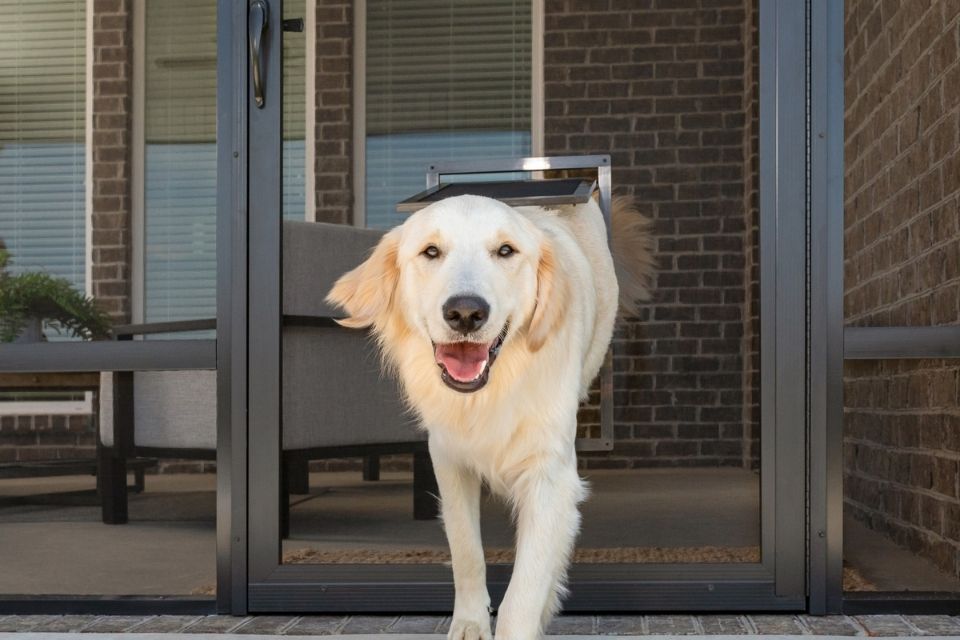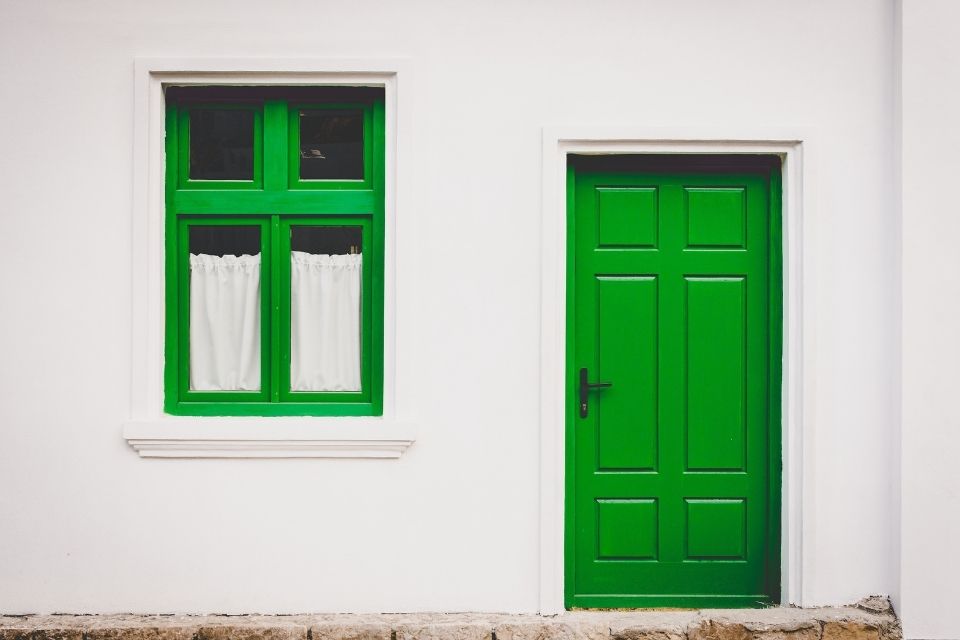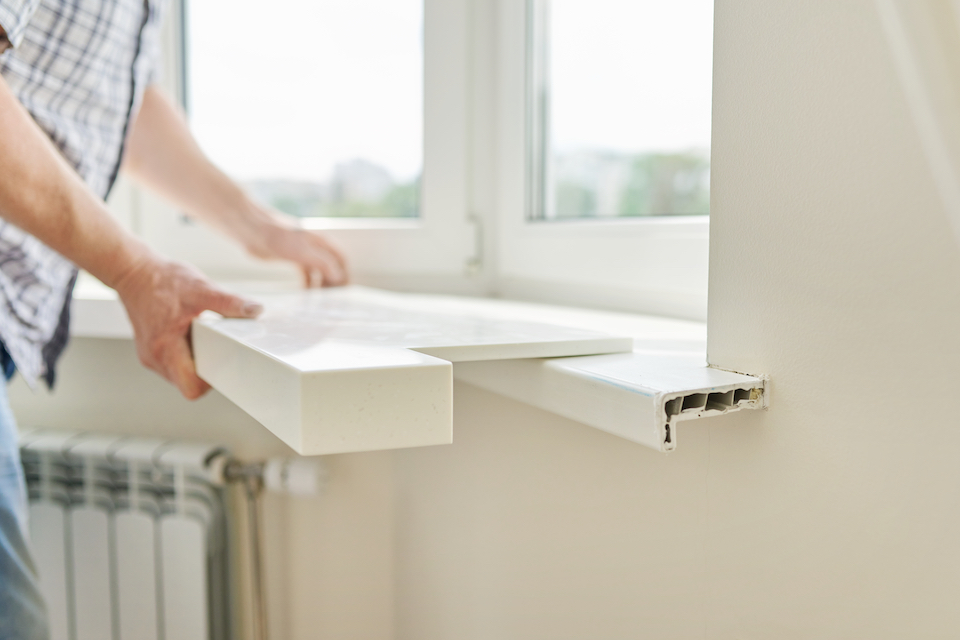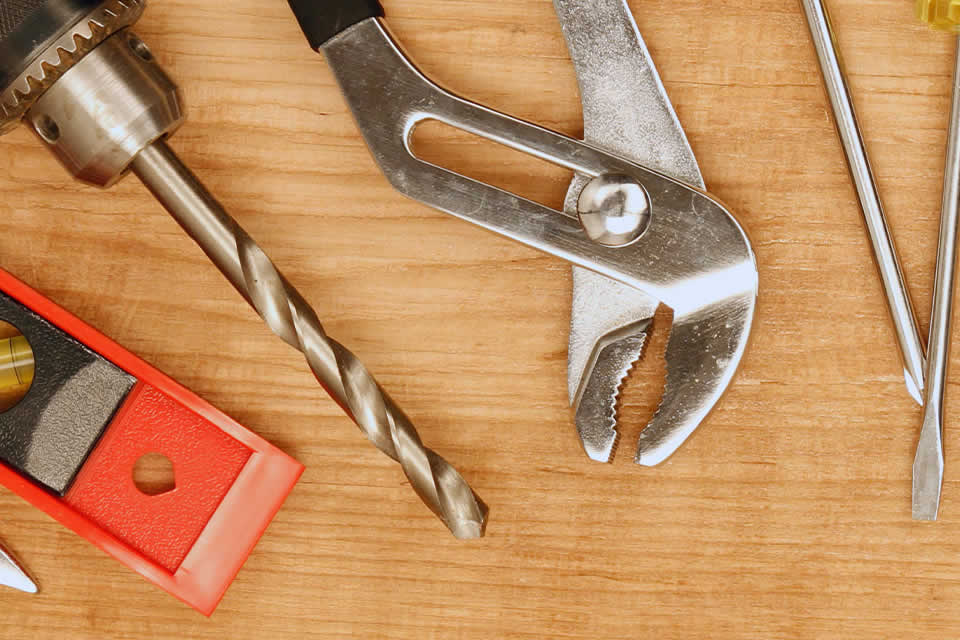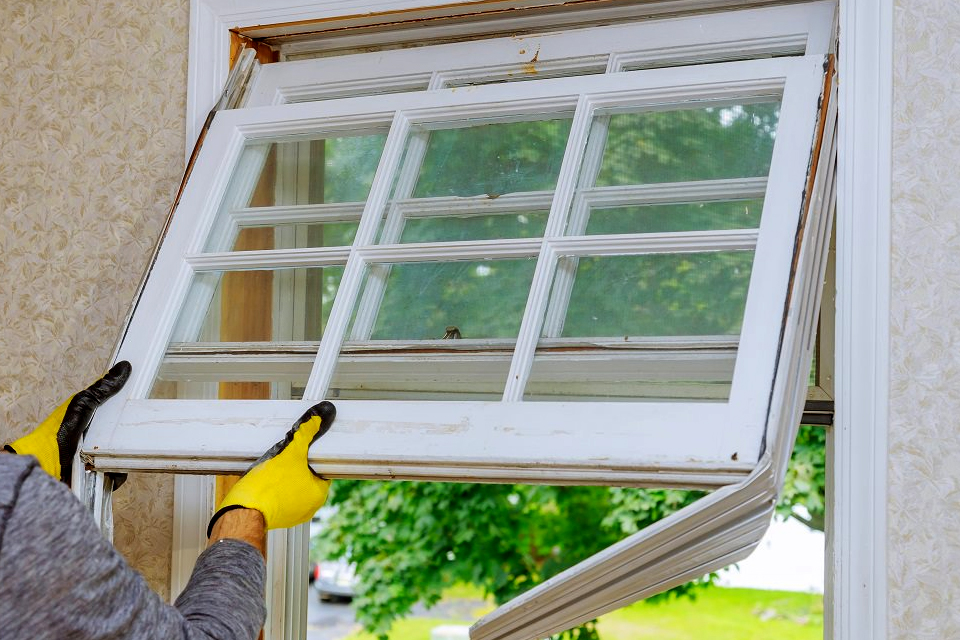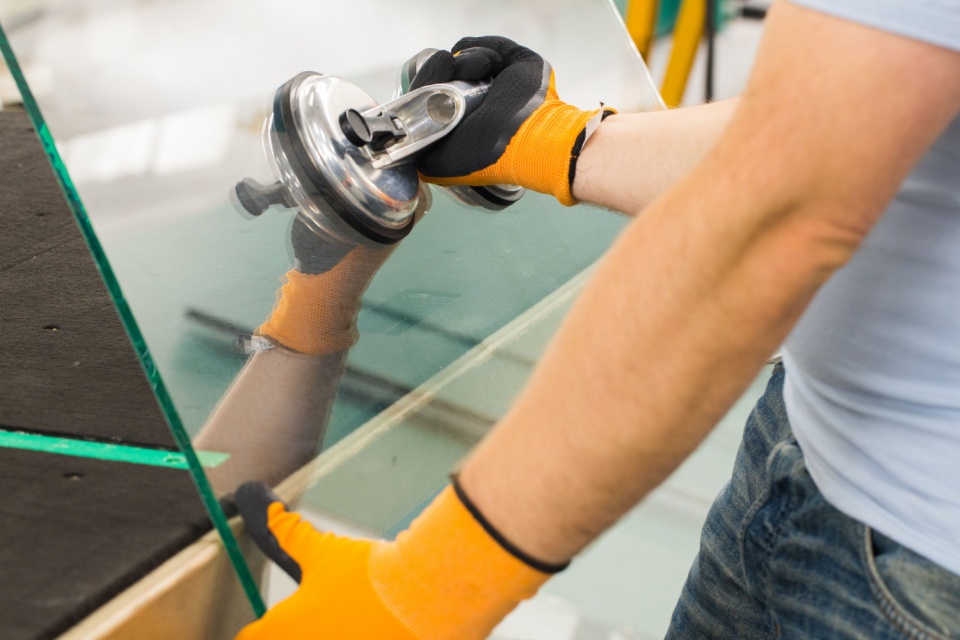How Much to Install a Cat Flap?
So, how much on average will you pay for a pet flap?
The average cost of fitting a pet flap is £100 to £250.
First, let’s take a look at how much installing different types of pet flaps would cost for a range of door types.
To have a classic pet flap fitted into a glass French door would cost about £150 to £250.
To fit this type of pet flap you’d need to budget for about £80 to £125 for a wooden door, £130 to £190 for composite doors, £80 to £120 for a uPVC door panel, or £240 to £450 to fit a classic pet flap into an external wall.
In the case of a lockable pet flap, the prices rise ever so slightly to about £150 to £255 for a glass French door, £80 to £130 for a wooden door, £130 to £195 for composite doors, £80 to £125 for a uPVC door panel, or £240 to £455 for an external wall.
You can expect a notably higher price tag if you go with a magnetic pet flap. To fit this type of pet flap into a glass French door would cost about £160 to £305.
You’d pay about £90 to £180 to fit it into a wooden door, £140 to £245 for composite doors, £90 to £180 in the case of a uPVC door panel, or £250 to £505 for an external wall.
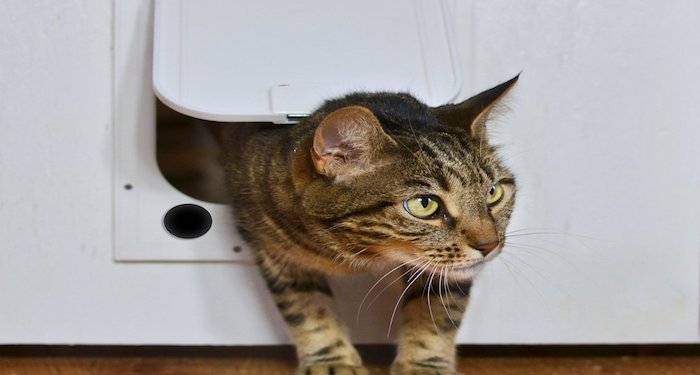
The estimated cost range of having an infrared or microchip pet door installed are the same, given that their average supply costs are identical.
To fit either of these pet flaps into a glass French door would land around £190 to £325, for a wooden door £120 to £200, or for composite doors £170 to £265.
It would set you about £120 to £195 to install either type into a uPVC door panel or £280 to £520 for an external wall.
What can change the cost of a pet flap?
Other important cost factors are the size and type of pet flap, ease of access and where in particular you are located.
Tradespeople charge different rates across the nation with the highest being found in the Southeast of England and London in particular.
Labour generally costs less in the north of England, Scotland, and Northern Ireland, however.
Cat Flap Installation Prices
| Flap Type | Door/Wall Type | Labour Cost | Supply Costs | Total Cost |
|---|---|---|---|---|
| Classic | Glass French Door | £80 to £150 | £70 to £100 | £150 to £250 |
| Wooden Door | £40 to £65 | £40 to £60 | £80 to £125 | |
| Composite Doors | £50 to £100 | £80 to £90 | £130 to £190 | |
| uPVC Door Panel | £40 to £70 | £40 to £50 | £80 to £120 | |
| External Wall | £120 to £250 | £120 to £200 | £240 to £450 | |
| Lockable | Glass French Door | £80 to £150 | £70 to £105 | £150 to £255 |
| Wooden Door | £40 to £65 | £40 to £65 | £80 to £130 | |
| Composite Doors | £50 to £100 | £80 to £95 | £130 to £195 | |
| uPVC Door Panel | £40 to £70 | £40 to £55 | £80 to £125 | |
| External Wall | £120 to £250 | £120 to £205 | £240 to £455 | |
| Infrared | Glass French Door | £80 to £150 | £110 to £175 | £190 to £325 |
| Wooden Door | £40 to £65 | £80 to £135 | £120 to £200 | |
| Composite Doors | £50 to £100 | £120 to £165 | £170 to £265 | |
| uPVC Door Panel | £40 to £70 | £80 to £125 | £120 to £195 | |
| External Wall | £120 to £250 | £160 to £270 | £280 to £520 | |
| Magnetic | Glass French Door | £80 to £150 | £80 to £155 | £160 to £305 |
| Wooden Door | £40 to £65 | £50 to £115 | £90 to £180 | |
| Composite Doors | £50 to £100 | £90 to £145 | £140 to £245 | |
| uPVC Door Panel | £40 to £70 | £50 to £110 | £90 to £180 | |
| External Wall | £120 to £250 | £130 to £255 | £250 to £505 | |
| Microchip | Glass French Door | £80 to £150 | £110 to £175 | £190 to £325 |
| Wooden Door | £40 to £65 | £80 to £135 | £120 to £200 | |
| Composite Doors | £50 to £100 | £120 to £165 | £170 to £265 | |
| uPVC Door Panel | £40 to £70 | £80 to £125 | £120 to £195 | |
| External Wall | £120 to £250 | £160 to £270 | £280 to £520 |
- How Much to Install a Cat Flap?
- How Much Does a Cat Flap Cost?
- Additional Cat Flap Installation Costs
- Tradesmen Cost for Installing a Cat Flap
- How Long Does It Take to Install a Pet Flap?
- Choosing a Cat Flap
- Installing Cat Flaps in Walls vs Doors
- Benefits of a Pet Flap
- How to Fit a Cat Flap
- How Much Does It Cost to Remove a Pet Flap?
- FAQs
- Sources
How Much Does a Cat Flap Cost?
This section is particularly relevant if you plan to fit a pet flap by yourself. We’ll break down the costs of buying the pet flap on its own based on type before considering the total supply costs for different installation jobs.
The latter cost can end up being a lot more than just the cost of the pet flap on its own as fitting a pet flap can involve the use of further materials/supplies.
A classic pet flap usually costs £10 to £25 and lockable pet flaps are available for a similar price of around £10 to £30.
If you’d like a magnetic pet flap, expect it to be roughly £20 to £80 in the store. Infrared and microchip pet flaps on the other hand, tend to cost between £50 and £100.
Moving on to specific jobs, the supply costs of fitting a classic pet flap to a glass French door will likely add up to around £70 to £100.
Assuming, again the same type of pet flap, expect total supply costs to be £40 to £60 for a wooden door, £80 to £90 in the case of composite doors, £40 to £50 to fit one into a uPVC door panel, or anywhere from £120 to £200 for an external wall installation.
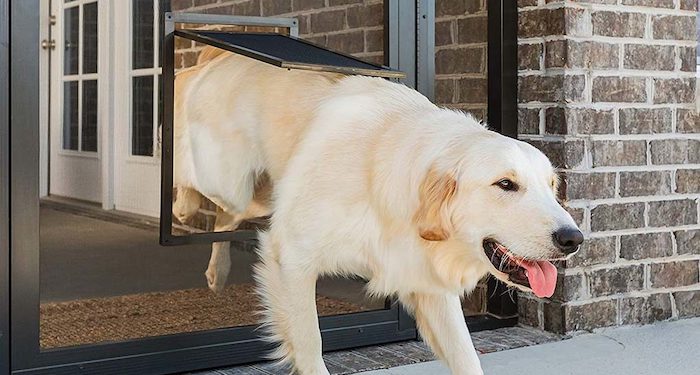
Looking at a lockable pet flap, the supply costs rise to £70 to £105 for a glass French door, £40 to £65 for a wooden door, £80 to £95 for composite doors, £40 to £55 for a uPVC door panel, or £120 to £205 in the case of an external wall.
To have a magnetic pet flap installed, would cost about £80 to £155 for a French glass door, £50 to £115 for a wooden door, £90 to £145 for composite doors, £50 to £110 for a uPVC door panel, or somewhere in the range of £130 to £255 for an external wall.
In the case of infrared and microchip pet flaps, the supply cost estimates are the same. To have either of these pet flaps fitted into a glass French door would probably cost £110 to £175.
Expect supply costs of about £80 to £135 for a wooden door, £120 to £165 for composite doors, £80 to £125 for a uPVC door panel, or between £160 and £275 for an external wall.
Supply Costs of Installing a Pet Flap
| Flap Type | Door/Wall Type | Supply Costs |
|---|---|---|
| Classic | Glass French Door | £70 to £100 |
| Wooden Door | £40 to £60 | |
| Composite Doors | £80 to £90 | |
| uPVC Door Panel | £40 to £50 | |
| External Wall | £120 to £200 | |
| Lockable | Glass French Door | £70 to £105 |
| Wooden Door | £40 to £65 | |
| Composite Doors | £80 to £95 | |
| uPVC Door Panel | £40 to £55 | |
| External Wall | £120 to £205 | |
| Infrared | Glass French Door | £110 to £175 |
| Wooden Door | £80 to £135 | |
| Composite Doors | £120 to £165 | |
| uPVC Door Panel | £80 to £125 | |
| External Wall | £160 to £270 | |
| Magnetic | Glass French Door | £80 to £155 |
| Wooden Door | £50 to £115 | |
| Composite Doors | £90 to £145 | |
| uPVC Door Panel | £50 to £110 | |
| External Wall | £130 to £255 | |
| Microchip | Glass French Door | £110 to £175 |
| Wooden Door | £80 to £135 | |
| Composite Doors | £120 to £165 | |
| uPVC Door Panel | £80 to £125 | |
| External Wall | £160 to £270 |
Additional Cat Flap Installation Costs
There is a mix of added costs that could appear when having a pet flap installed. In this section, we’ll break down some everyday examples.
Minimum Fee
A lot of contractors will have a standard minimum fee which may be added to the overall cost.
On the other hand, if the job is especially quick, such as fitting a small pet flap into a wooden door (usually an hour or less), a minimum fee may be set to ensure that the job and getting there is worth their time.
Type of Pet Flap
As already discussed, the type of pet door flap can be a significant cost factor. Classic and lockable pet flaps are the cheapest options, costing as little as £10 or less.
On the other end of the price range are infrared and microchip pet flaps which tend to cost between £50 and £100.
Size of Pet Flap
The size of the pet flap is a negligible factor, given that there is already a significant price difference between the different types of pet flaps.
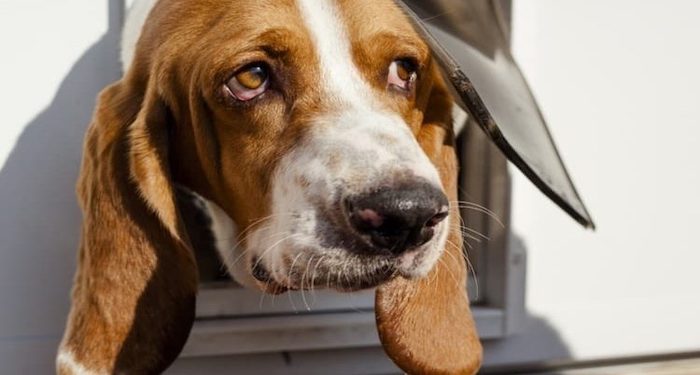
However, it still can alter the overall installation cost, even if only by a few percent in most cases.
Quality/Brand of Pet Flap
It goes without saying that the higher the quality of the pet flap, the more the product will cost. Some brands will also sell products with higher price tags than other, more budget-oriented pet brands.
You’ll also find that the cat flap cost or dog flap cost on websites like eBay will generally be less than on brand sites.
Duration
The longer it takes to fit a pet flap, the higher the labour cost will likely be. To give some stand out contrasts, fitting a small pet flap to a uPVC door panel will probably only take an hour but installing a large pet flap into a glass French door could involve half a day’s work.
Replacing a Glass Door With uPVC Door Panel
If you decide to have a glass door replaced with a uPVC door panel and a new pet flap fitted, expect anywhere from £70 to £100 to be added to your total expenses.
If you are just replacing a glass panel with double glazing to house your new pet flap expect to pay around £155.
Gardener
As your dog will now have more access to the garden you may find the upkeep of the garden gets a little harder. Especially if your dog likes to dig or chew.
Hiring a gardener to do regular maintenance would help keep your garden looking its best even if your dog is being a little naughty with its new found freedom.
If there are areas of your garden that you would prefer to be sectioned off, a gardener could also help install fencing. This could not only keep your dog safe and secure, but could also keep your flower beds and borders from being destroyed.
The average hourly rate for a gardener is between £12 - £59 per hour. This does depend on where you live, the size of your garden and the quantity of work needed each visit.
Home Security
A pet flap, when installed correctly, shouldnt have an impact on your home security. However if this is a worry to you you may wish to added some kind of CCTV system.
CCTV systems can be as basic or as complex as you wish. You may wish to install camera around the whole perimeter of your property to ensure all angles are covered. If cameras are visible, they will usually deter intruders away from your home. Camera systems will usually cost around £70-£270 per camera.
Motion sensor lights are also a good way of deterring intruders. They also give light to pets using the garden at nighttime.
To install a motion sensor outdoor light, you would be looking to pay between £150 – £500.
Tradesmen Cost for Installing a Cat Flap
Let’s now take a closer look at the labour costs of having a pet flap installed. These costs will vary depending on the door type and size of the pet flap.
We’ll break down the costs based on these factors during this section and look at how much labourers charge per hour for this type of work.
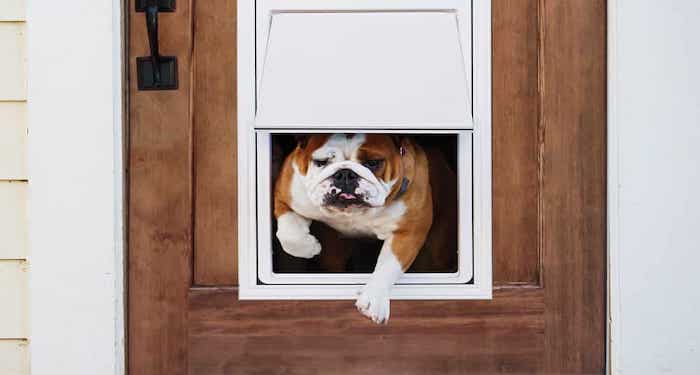
Most tradespeople charge about £40 to £50 an hour for this type of work. The cost of labour varies across the nation, however.
Labour Costs Based on Door Type
- £80 and £150 for a glass French door
- £40 to £65 for a wooden door
- £50 to £100 for composite doors
- £40 to £70 for a uPVC door panel
- £120 to £250 for an external wall
How Long Does It Take to Install a Pet Flap?
The time it takes to fit a pet flap can vary significantly depending on the size of the pet flap and the type of door/wall it is being fitted to.
As with the labour costs, the type of pet flap (i.e. classic, lockable, microchip, etc.) is not especially important in shaping the duration of the work. We’ll now discuss the timeframe of fitting a pet flap based on the two key time factors.
| Door Type | Small Pet Flap | Medium Pet Flap | Large Pet Flap |
|---|---|---|---|
| Glass French Door | 1–2 hours | 3–4 hours | 4–5 hours |
| Wooden Door | 1 hour | 60–90 minutes | 1–2 hours |
| Composite Door | 1–2 hours | 1.5–2.5 hours | 2–2.5 hours |
| uPVC Door Panel | 1 hour | 60–90 minutes | 1.5–2 hours |
| External Wall | 1.5–2 hours | 2–3 hours | 3–4 hours |
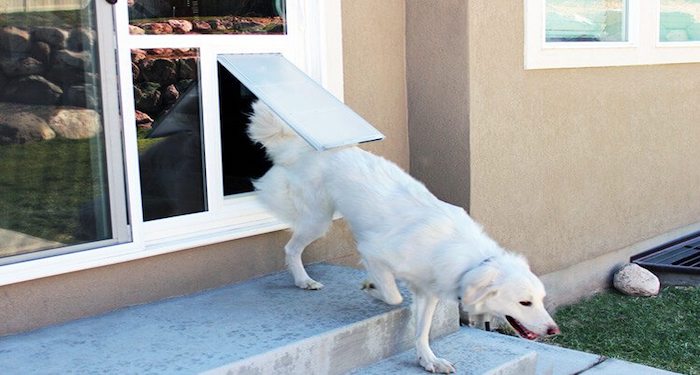
Choosing a Cat Flap
While we have broken down the price differences of the various types of pet flap (or lack thereof in some cases), this doesn’t tell you much about their value for money.
In this section, we’ll discuss the main types of pet flap, and look at their features and pros & cons.
Classic Cat Flap Cost
A conventional cat or dog flap is cheap and straightforward. It is simply a two-way pet flap which is usable at any time.
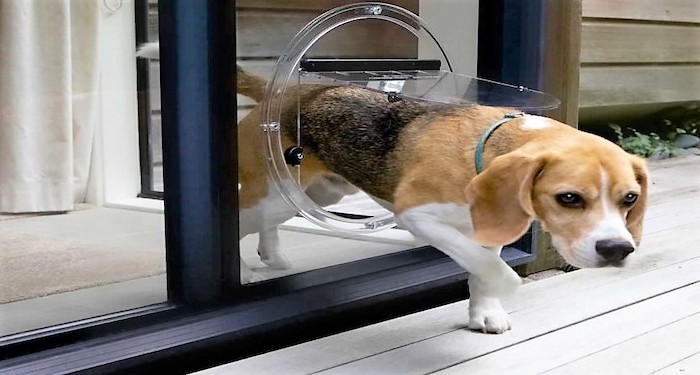
These pet doors are cheap and depending on your needs, may prove entirely satisfactory. However, classic pet flaps are not very secure.
Neighbourhood pets and even wild animals could make their way into your home using a classic pet flap and it will not prove very protective against the elements either. On average, classic pet flaps cost about £10 to £25 per unit.
Pros:
- Inexpensive
- Straightforward
Cons:
- Does not offer security
- Not protected against the elements
Lockable Cat Flap Cost
For a little more security and for only a small increase in supply costs (if any), you should consider a lockable pet flap.
These pet flaps can be locked manually whenever you’d like. This lets you decide when your pet can go in and out and more importantly, it will prevent other pets or wildlife paying an unwelcome visit.
In addition, a lockable pet flap can give you peace of mind when going to bed each night that your home is not vulnerable to a break-in.
Despite its advantages, a lockable pet flap is still completely insecure when unlocked. Beyond that, if the locking mechanism breaks or jams, you may need to pay a professional to come by and fix the issue. On average, a lockable pet flap costs between £10 and £30.
Pros:
- Increased security when locked
- Relatively cheap
Cons:
- Only secure when locked
- Risk of jamming or other mechanical faults
Infrared Cat Flap Cost
Though usually more expensive, infrared pet flaps are highly beneficial due to the security that they offer.
With this type of pet door, you will have an infrared key that can be attached to your dog or cat’s collar.
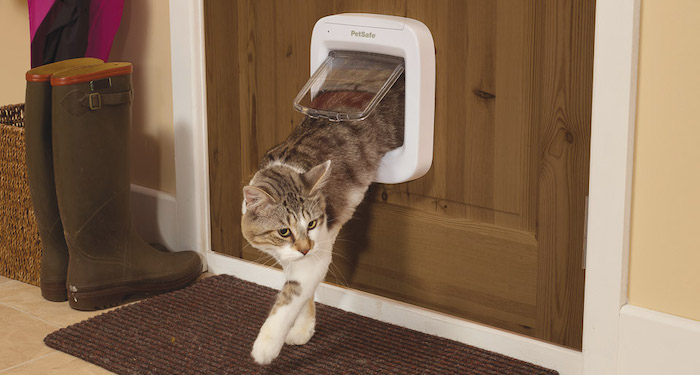
This key will trigger the lock on the pet flap when they approach and allow them to pass through but the door will remain locked if another animal approaches.
You can buy multiple keys if you’d like, however, meaning that you can extend access to several animals such as if you have additional household pets. Infrared pet flaps generally cost between £50 and £100.
Pros:
- Highly secure
- Possible to buy several infrared keys
Cons:
- Expensive
Microchip Cat Flap Cost
A similar pet flap to an infrared one is that which is based on microchip security/access. Though expensive, microchip pet flaps are very secure.
Every pet’s microchip is coded distinctly and these pet flaps can be set to grant access only when it detects your pet’s microchip is in close proximity.
You can set this type of pet flap to detect microchips from several pets, if you’d like.
Since there is always a small risk that your pet’s infrared key could be lost or worn down over time, a microchip pet flap offers the best quality overall.
Microchip pet flaps usually cost between £50 and £100.
Pros:
- Highly secure
- Can provide several pets with access
- More reliable than an infrared option in the long-term
Cons:
- Costly
Magnetic Cat Flap Cost
Magnetic pet flaps tend to be cheaper than infrared or microchip pet flaps while offering a similar function.
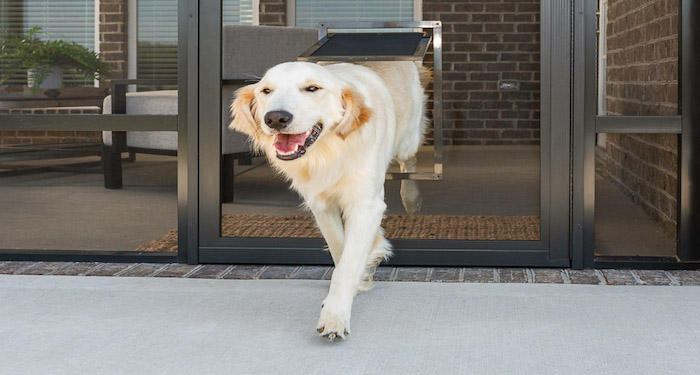
This type of pet flap opens in response to the presence of a collar or tag that can be placed on your pet.
The downside of a magnetic pet flap is that it may take time to correctly detect your pet’s collar/tag and there is a risk of a neighbour’s cat or dog having the same type of collar/tag since these pet flaps tend not to be as scientific as infrared or microchip pet flaps.
Magnetic pet flaps usually cost somewhere in the range of £20 to £80.
Pros:
- Magnetic cat flap or dog flap is secure
- Less expensive than infrared or microchip pet flaps
Cons:
- May take time to work
- Neighbourhood pet’s may gain access
Installing Cat Flaps in Walls vs Doors
When choosing where to install your pet flap, the decision often comes down to whether it should be fitted into a wall or a door. Both options have their own advantages and potential drawbacks. Below, we break down the key differences to help you choose the best solution for you.
Pet Flap in a Door
Pros:
- Generally easier and quicker to install
- Lower installation costs
- Easier to replace or upgrade the flap
- Less structural work required
Cons:
- May not be suitable for all door types (e.g. metal or ornate front doors)
- Can reduce insulation or security depending on flap type
- Might not be ideal in rented properties
Pet Flap in a Wall
Pros:
- Flexible placement options (you can choose the most convenient location)
- Can preserve the look and function of your main doors
- Often more secure and better insulated with tunnel systems
Cons:
- More complex installation, often requiring a professional
- Higher installation costs
- Difficult and expensive to remove or relocate later
- Potential for encountering wiring or pipes during installation
Door installations are a simpler and cheaper option. However wall installations can offer more flexibility and better energy efficiency long term.
Benefits of a Pet Flap
There are many advantages to installing pet flaps in the home. In this section, we’ll look at some of the clearest benefits.
Health
For starters, a pet flap can improve the health of your pet in various ways. A pet may not necessarily communicate that they need to go outside when in need of urinating or they may refrain from doing so for some time if they are at home on their own.
With a pet flap, it will reduce risks of your pet suffering from urination-related health issues like UTIs. It can also give your pet more access to sunlight, fresh air, and exercise whenever they want.
Freedom for Your Pet
Not only is it healthier for your pet to spend more time outside but they’ll simply be happier too.
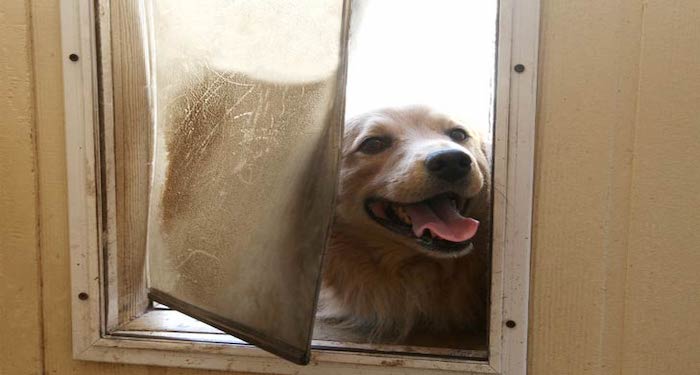
A pet flap means less time for your pet to wait stressed or barking/meowing at the back door and more time being outside enjoying their freedom. This can play a role in allowing a dog or cat to better embrace their natural behaviours too.
Exercise
As discussed, pet flaps will allow your dog or cat to exercise when they wish (as long as it’s not locked).
In turn, this may mean they won’t need to go out for as many walks although this shouldn’t be assumed either. Regardless, more exercise will mean that your pet will be less stressed and overall, they’ll likely enjoy life more.
Convenience for You
It will also make things more convenient on your end. Firstly, when your pet wants to go outside or comeback in, you won’t have to get up and open and close the door. So your pet would be happier and so would you.
Interior Condition
The above benefits may in turn prove beneficial for the interior state of your home. After all, if your pet doesn’t need to scratch at the door or is less stressed (and therefore less likely to create messes around the house), your home’s interior should see less damage than it would otherwise.
How to Fit a Cat Flap
If you are wondering how a pet flap gets installed let us explain. Below is an overview of the tools and steps required to fit a standard pet flap into a wooden door.
Tools You’ll Need
- Ruler
- Measuring Tape
- Pencil
- Protective Eyewear
- Jigsaw
- Set Square
- Electric Drill
- Screwdriver
- Wood File
- Sandpaper
Step-by-Step Cat Flap Installation
- Start by measuring your pet’s belly height and mark this height on the door where the flap will be installed.
- Using a set square and ruler, draw a rectangle starting from the marked height—this will outline the cut-out area for the pet flap. Double-check your measurements and ensure the positioning is right before proceeding.
- Put on your safety glasses. Then drill holes through the door at each of the rectangle’s corners.
- Carefully cut along the lines from corner to corner using a jigsaw to create the opening.
- Smooth the inner edges of the cut-out using sandpaper or a wood file to avoid splinters.
- Take off any blanking plugs from the pet flap. Hold the flap against the door, ensuring the locking mechanism faces inward.
- Mark the screw hole positions using a pencil.
- Remove the flap, drill pilot holes where marked, then reposition the flap and secure it with screws. Finish by snapping on the blanking plates to cover the screws for a neat appearance.
Important Things To Remember
- Ensure you measure how thick your door is before you start installing the pet flap. Pet flap should be able to fit into any door but if your door isnt a standard thickness you may need longer screws.
- Make sure you fit your pet flap on the hinge-side of the door. This helps to prevent possible intruders from being able to reach your door handle or latch through the pet flap.
- Make sure your keys are never left anywhere within reach of the pet flap once it has been installed. If your home is broken into without any sign of forced entry, your insurer may refuse to pay out if they believe that a thief has accessed your home by reaching your keys via the pet flap.
How Much Does It Cost to Remove a Pet Flap?
You may decide to have a pet flap removed because you’d like to upgrade to a more secure option (e.g. replacing a classic pet flap with a microchip pet flap) or because you’ve figured that pet flaps are more of a nuisance than advantageous.
Though the latter scenario is unlikely, it can depend on what type of pet flap you have installed and whether you’d want to spend money having it replaced with a higher quality product.
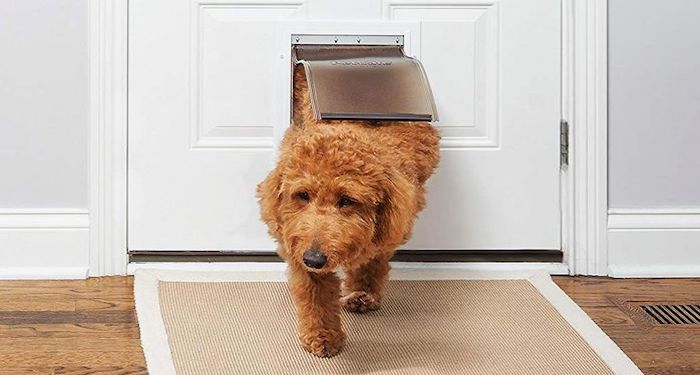
On the other hand, it may be because your pet has sadly passed on to dog or kitty heaven. Removing a pet flap will probably cost under £100 but it will depend on the type of pet flap among other factors.
FAQs
Q: How do you fit a cat flap in a uPVC door?
A: For starters, you’ll need all of the necessary tools and supplies. The manufacturer of the pet flap should provide you with the necessary instructions.
Also make sure to check that your pet is not on the other side of the door when cutting out the circle for the cat flap! Broadly speaking, the following steps will be required;
- Measure where on the door to fit the pet flap
- Mark the centre of the door
- Mark the outline of the pet flap on the door
- Drill holes on the circle outline
- Use a jigsaw blade to cut out the door circle
- Tidy up the hole with sand-paper
- Ensure that the flap swings correctly
- Drill the fixing holes
- Per the instructions, fix the cat flap into place
- Check again that it’s working okay
Again, please follow the manufacturer’s instructions precisely, if provided.
Q: What is the best way to train a cat to use a pet flap?
A: While some cats may intuitively figure out how to use a pet flap, others will not. It’s important that you don’t push your cat to go through too quickly since fear could be the main thing holding them back.
You could temporarily remove the door and let them go in and out of the hole before adding the flap. Alternatively, you could temporarily replace the flap with cloth that hangs over the hole.
If your cat is especially nervous, make sure that the cloth covers the entire hole. With the pet flap fitted in place, you could use rewards like their very favourite treats placed outside.
You don’t want to overdo it for dietary reasons and because it may devalue the treat in their mind if they have it too often. However, using positive incentives and being patient should work.
Q: How long do batteries last for on a microchip pet flap?
A: Usually for about six months.
Q: What is the best type of pet flap?
A: Microchip pet flaps are the best option but it depends on your requirements. In some cases, a classic or lockable dog flap or cat flap will suffice.
Q: Can I fit a pet flap door DIY?
A: If you know precisely what is involved and are confident about your skills/knowledge, then yes absolutely you can install a pet flap without hiring a professional.

